Mount Wutai
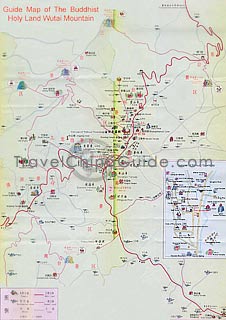 |
| Map of Wutai Mountain |
Mount Wutai Facts
Area: 2,837 square kilometers (1,095.4 square miles)
Average Altitude: 1,000 meters (over 3,281 feet)
The most holy land of Chinese Buddhism, Mount Wutai is rated on both the list of the first group of national scenic spots designated by the State Council, and the list of the Top 10 scenic spots in Shanxi Province. It is as famous as Mt. Emei in Sichuan Province, Mount Putuo in Zhejiang Province, and Mount Jiuhua in Anhui Province, all of which are renowned as the four sacred Buddhist Mountains. Its five main peaks, positioned east, south, west, north, and in the middle, embrace one another with broad and plain terraces rather than forests on their tops. That is why it bears the name "Wutai Shan" (Mountain of Five Terraces). The summit of the northern peak which is famed as being the "Roof of Northern China", reaches 3061.1 meters (10,043 feet). Besides the religious aspect, the beauty of rising and falling ridges of mountains, exotic rocks, crisscrossed gullies, crystalline waters and towering green forests also gives the mountain its reputation as a colorful and notable scenic resort.
The beautiful scenery in Mount Wutai is a masterpiece of exquisite acts of nature, predominantly visible over the five main peaks: Wanghai Peak in the east, Guayue Peak in the west, Jinxiu Peak in the south, Yedou Peak in the north, and the central Cuiyan Peak.
Wanghai Peak (Peak Overlooking the Sea) in the East
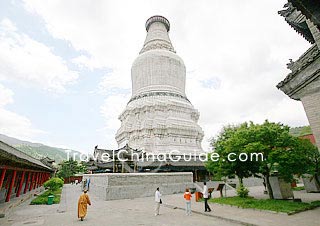 |
| Great White Pagoda in Tayuan Temple, Mount Wutai |
Guayue Peak (Hanging Moon Peak) in the West
Jinxiu Peak (Splendor Peak) in the South
Yedou Peak (Peak of Flourishing Leaves) in the North
Cuiyan Peak (Peak of Green Rocks) in the middle
Wutai Mountain Temple
Xiantong Temple
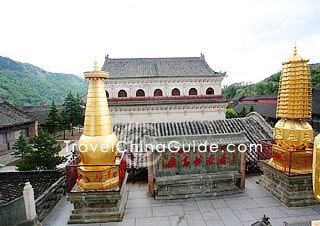 |
| Xiantong Temple |
Tayuan Temple
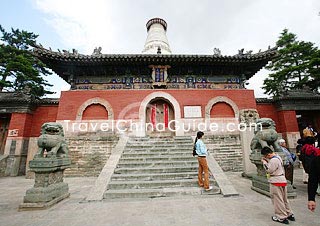 |
| Tayuan Temple |
Manjusri Temple
Shuxiang Temple
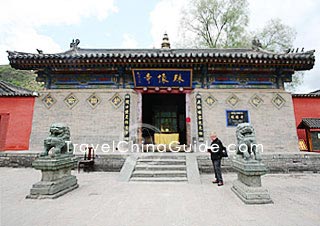 |
| Shuxiang Temple |
Luohou Temple
For tourists who want to visit all Manjusri Bodhisattva's statues in the five temples but cannot for time constraints or other reasons, Dailuo Peak (Dark Green Snail Peak) is a wonderful place to visit, because Wufang Manjusri Palace (Palace of Manjusri Bodhisattvas from five directions) houses statues resembling the five Manjusri Bodhisattvas of each terrace. It is located to the east of the temple group in the center of Taihuai Town. 1,080 steps lead to the top of the snail-shaped peak and a cable car is also available for convenience.
Besides these temples, there are other exquisitely constructed ones, such as Jinge Temple (golden temple), Nanchan Temple, Dailuoding, Shifangtang, Wangfo Temple, and so on.
Other Resources
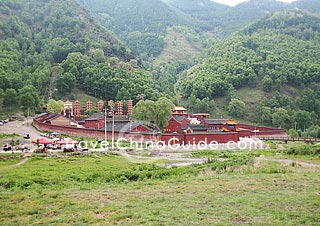 |
| Shancai Cave |
Over 600 species of plants can be found, of which more than 150 species of grass can be used as rare herbs. Special local produce, Taimo, (mushrooms grown on the tops of peaks of Mount Wutai) is of quite high nutritional value and with a delicate taste.
Since many temples are interspersed in Mount Wutai, numerous art works were cared for and have been preserved as relics-sculptures, murals, calligraphy, as well as architecture. Pagodas built in the style of those in ancient India added new types to traditional ones. Nanchan Temple and Foguang Temple, built in the Tang Dynasty, are representatives of the ancient wooden style of construction, and have the longest history amongst the temples in the mountain.
How to get to Mount Wutai
How to get to Wutai Shan by bus
2. Take a bus from Taiyuan East Bus Station to Wutaishan Bus Station, and then take a taxi to the mountain area. The bus is available from 6:30 to 9:10 with an internal of about 30 minutes.
How to get to Wutai Shan by train
How to get to Wutai Shan by air
| Entrance Fee | Apr. - Oct.: CNY 135 Nov. - Mar.: CNY 118 Free for children under 1.2m (3.9 feet) |
|---|---|
| Opening Hours | The mountain area opens all day, but scenic spots opens roughly from 6:30 to 20:00. |
| Cable Car Ticket | Dailuo Peak: CNY 50 (one-way); CNY 80 (round-trip) |
| Fomu Cave: CNY 50 (one-way); CNY 85 (round-trip) | |
| Cable Car Service Hours | 7:00 - 17:00 (only for reference) |
- Last updated on Apr. 12, 2024 -
Questions & Answers on Mount Wutai
Asked by Gal from ISRAEL | Apr. 11, 2024 07:43 Reply
Reply
Where should i sleep in Taihuai? what is the best way to book?
Answers (1)
Answered by Randy | Apr. 12, 2024 02:47 0
0 0
0 Reply
Reply
You can stay inside Wutaishan Scenic Area. Hotels like Hanting Hotel, Green Tree Inn Express Hotel and Starway Hotel are for your choice. You can search them online and book in advance.
Asked by Alf from SINGAPORE | Jan. 05, 2024 19:42 Reply
Reply
Mount Wutai to Hengshan (Mt Hengshan)
What is the route from Mt Wutai to Hengshan and how long it takes to be there? Thanks in advance!
Answers (1)
Answered by Hailey | Jan. 08, 2024 23:30 0
0 0
0 Reply
Reply
I'm sorry but it seems there is no public transport available between the two places. The best way is to hire a car directly. The distance between two places is about 150km and 2-3 hour are needed by car.
Asked by tan from SINGAPORE | Dec. 25, 2023 02:51 Reply
Reply
Getting from Mount Wutai to Zhengzhou - Zhu Ma Dian West Station
How can I get from Mount Wutai to Zhengzhou - zhu ma dian west?
Answers (1)
Answered by Diana | Dec. 25, 2023 18:13 0
0 0
0 Reply
Reply
There is no direct train available. You can take a train from Mount Wutai to Taiyuan first and then transfer to Taiyuan South to Zhu Ma Dian West by high speed train.
Asked by Terry from NEW ZEALAND | Apr. 22, 2023 20:52 Reply
Reply
Travel from anhui to Wu tai shan
I intend to visit Wu tai Shan in September. Is there a high speed train from anhui tongling to Wu tai Shan
Answers (1)
Answered by Rome | Apr. 25, 2023 01:56 0
0 0
0 Reply
Reply
It is a pity that there is not any bullet train between the two places. However, you can take a bullet train from Tongling or Tongling North Station to Hefei South Station, where you can continue to take a high speed train to Taiyuan South. A train can help you to reach Wutaishan from Taiyuan South Train Station.
Asked by Rev. Vimutti from SRI LANKA | Feb. 26, 2020 12:53 Reply
Reply
Wutaishan Five Peaks closure period
I plan to go to Wutaishan from October 10th to 15th, and one day to visit the five peak. Will the peaks be closed, abd is vehicle still avaliable.?
Answers (1)
Answered by Carrie from AUSTRALIA | Feb. 27, 2020 17:46 0
0 0
0 Reply
Reply
As I know, it will open during that period of time.